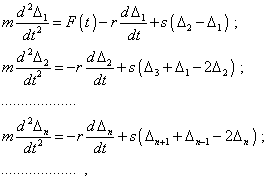Second, the solutions that one can yield by a conventional
method are quite incomplete. As [10]–[13] show, the conventional methods do not
enable us to study vibrations in the overcritical domain (over the boundary frequency  0). ''Solution of the boundary problems of vibration theory is basically
reduced to determine the eigenvalues determination connected with the natural frequencies
or other parameters of the studied system and to finding the eigenfunctions (vibration
forms). If the eigenvalues and eigenfunctions have been found, we can think the boundary
problem solved... At present a great number of approximate methods has been developed for
finding the eigenvalues, but they all are quite laborious, give only the first
eigenvalues, and the main, do not unite the study of systems with discrete and continuous
mass distribution'' [5, p. 3- 4]. Only in some particular cases we have the
incomplete, limitedly applicable solutions or mentionings that processes in the
overcritical domain are possible (see, e.g., [7, p. 282–285], [8, p. 294], [14, p.
109]). At the same time, it is inherent in the vibration process in this domain that at
the frequencies higher than critical, even an ideal elastic line behaves as a natural
damper with along-the-line damping vibration amplitude. As we will show in this paper, the
resistance essentially effects on the damping characteristics, as well as on the vibration
pattern of the system elements. To make the analysis complete and high-quality, it is
important to take into account, how the resistance effects on the elastic system
vibrations. In our present study we will intentionally confine ourselves to a simple model
of a semi-infinite 1D elastic line, to visualise the analysed processes. We will suppose
that for other types of elastic lines we can obtain the alike results, since now we have
available such exact analytical solutions as have been presented in [10]–[13]. 0). ''Solution of the boundary problems of vibration theory is basically
reduced to determine the eigenvalues determination connected with the natural frequencies
or other parameters of the studied system and to finding the eigenfunctions (vibration
forms). If the eigenvalues and eigenfunctions have been found, we can think the boundary
problem solved... At present a great number of approximate methods has been developed for
finding the eigenvalues, but they all are quite laborious, give only the first
eigenvalues, and the main, do not unite the study of systems with discrete and continuous
mass distribution'' [5, p. 3- 4]. Only in some particular cases we have the
incomplete, limitedly applicable solutions or mentionings that processes in the
overcritical domain are possible (see, e.g., [7, p. 282–285], [8, p. 294], [14, p.
109]). At the same time, it is inherent in the vibration process in this domain that at
the frequencies higher than critical, even an ideal elastic line behaves as a natural
damper with along-the-line damping vibration amplitude. As we will show in this paper, the
resistance essentially effects on the damping characteristics, as well as on the vibration
pattern of the system elements. To make the analysis complete and high-quality, it is
important to take into account, how the resistance effects on the elastic system
vibrations. In our present study we will intentionally confine ourselves to a simple model
of a semi-infinite 1D elastic line, to visualise the analysed processes. We will suppose
that for other types of elastic lines we can obtain the alike results, since now we have
available such exact analytical solutions as have been presented in [10]–[13].
2. Exact analytical solutions for
a semi-infinite 1D elastic resistant lumped line
Seeking the exact analytical solutions for a studied
elastic line, we will choose not a conventional way to find the particular solutions for a
modelling system of differential equations. We will try to reduce the problem to the
solutions for an ideal line presented in [10], the more it will be simple.
In our case the modelling system of differential equations
will be |
